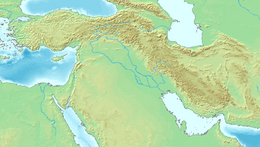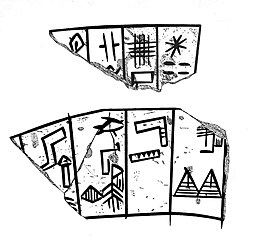Hamazi
Topic: History
 From HandWiki - Reading time: 4 min
From HandWiki - Reading time: 4 min
Hamazi or Khamazi (Sumerian: 𒄩𒈠𒍣𒆠, ha-ma-ziki, or 𒄩𒈠𒍢𒆠 Ḫa-ma-zi2ki)[4] was an ancient kingdom or city-state which became prominent during the Early Dynastic period. Its exact location is unknown.
History
In the early days of archaeology two pottery fragments were found in Nippur which it was assumed were part of the same vessel (CBS 9571+CBS 9577). One referred to a Uhub/Utug ruler of Kish and the other to an unknown ruler defeating Hamazi. Subsequent analysis showed that the two fragments did not in fact belong to the same vessel.[5] The relevant fragment (BM 129402) reads "[To the deity DN P]ussussu, vanquisher of Hamazi, dedi[cated] (this vessel).".[6]
One of the earliest references to Hamazi is found in the epic literary composition Enmerkar and the Lord of Aratta, where Enmerkar prays to Enki about the confusion of languages in the various inhabited lands, at the time of the building of the ziggurats in Eridu and Uruk. Hamazi is the only land mentioned in this prayer with the epithet "many-tongued". A sequel, Enmerkar and En-suhgir-ana also mentions that the sorcerer of Hamazi, Urgirinuna, went to Aratta after Hamazi "had been destroyed"; he is later sent by the Lord of Aratta on a failed mission attempting to bring Enmerkar into submission.[7][8]
According to the semi-literary Sumerian King List, king Hadanish of Hamazi held hegemony over Sumer after defeating Kish, but was in turn defeated by Enshakushanna of Uruk.[9]
A clay tablet found in the archives at Ebla in Syria bears a copy of a diplomatic message sent from king Irkab-Damu of Ebla to king Zizi of Hamazi, along with a large quantity of wood, hailing him as a brother, and requesting him to send mercenaries in exchange. A tablet from a few years later states " ... 470 g. of silver of the king of A. which the king of Hamazi has handed over and is his giving (as) a gift to PN, the representative-messenger, (for) the king of Ebla".[10] A later analysis of the toponyms in the tablets in question indicate that the Hamazi mentioned in the Elba tablets is actually a different Hamazi, at modern Qalah Hom, the “citadel hill” of modern Homs.[6]
Hamazi was one of the provinces of Ur under the reign of Amar-Sin during the Ur III period. Two governors or ensis during this reign named Lu-nanna son of Namhani, and Ur-Ishkur are recorded in tablets from Drehem. The first, Lu-nanna, was recorded in Amar-Sin year 1 and then in year 2: "when His Majesty drank beer in the house of Lu-Nanna, son of Namhani, the ruler of Hamazi.". By the 5th year of Amar-Sin Ur-Ishkur is mentioned as governor of Hamazi. In year nine his daughter-in-law is mentioned "when Ur-Iskur, ruler of Hamazi, 'brought/fetched' his daughter-in-law". We learn her name in an inscription from AS7 "when Tabur-hattum, the daughter-in-law of the ruler Ur-Iskur, when she went (back) to Hamazi". A further possible ensi, under Su-Sin, was Arad-Nanna, though that is thinly attested. [11][12][13] According to a letter from Puzur-Numušda, governor of Kazallu, in the last days of the Ur III empire wrote to Ibbi-Sin, last ruler of that empire and claimed that the land of Hamazi was plundered by Ishbi-Erra of Isin. He also claimed that the god Enlil had promised Isbi-Erra dominion "from the land of Hamazi (down) to the Sea of Magan".[14][15]
Location
Hamazi is thought to have been located in Zagros Mountain region somewhere between the Upper Zab and Diyala Rivers. The mention of a "Šu-Eštar of Hamazi" and another person named Ititi from there in Old Akkadian documents found at Nuzi sparked suggestions that Hamazi was nearby.[15] One researcher proposed that Hamazi was the later Old Babylonian period city of Ekallatum.[16] Two researchers have proposed that "Hamazi is located at the site of Kani Jowez about 10 kms SE of modern Halabjah".[6]
List of rulers of Hamazi
| Ruler | Notes and references |
|---|---|
| Hadanish | according to Sumerian King List |
| Lu-nanna | Governor under Ur III ruler Amar-Sin |
| Ur-Ishkur | Governor under Ur III ruler Amar-Sin |
See also
- List of cities of the ancient Near East
References
- ↑ "CDLI-Archival View". https://cdli.ucla.edu/search/archival_view.php?ObjectID=P222740.
- ↑ "Collections Online British Museum". https://www.britishmuseum.org/collection/object/W_1939-0612-1.
- ↑ Thureau-Dangin, F. (François) (1905). Les inscriptions de Sumer et d'Akkad, transcription et traduction. Paris, Leroux. p. 229. https://archive.org/details/lesinscriptionsd00thuruoft/page/228/mode/2up/search/hamazi.
- ↑ The Sumerian King List. Accessed 15 Dec 2010.
- ↑ Cooper, Jerrold S., "Studies in Mesopotamian Lapidary Inscriptions. III1", Iraq 46.2, pp. 87-93, 1984
- ↑ 6.0 6.1 6.2 Douglas Frayne, "Unattributed", in Presargonic Period: Early Periods, Volume 1 (2700-2350 BC), Toronto: University of Toronto Press, pp. 441-444, 2008 ISBN:9780802035868
- ↑ Kramer, Samuel Noah, "Enmerkar and the Lord of Aratta: A Sumerian Epic Tale of Iraq and Iran", Philadelphia: University of Pennsylvania Press, 1952
- ↑ Ansky, S., "Enmerkar and the Lord of Aratta", The Harps that Once..., edited by David G. Roskies, New Haven: Yale University Press, pp. 275-319, 1992
- ↑ Jacobsen, Thorkild (1939). The Sumerian king list. Chicago (Ill.): the University of Chicago press. ISBN 0-226-62273-8. OCLC 491884743. https://isac.uchicago.edu/sites/default/files/uploads/shared/docs/as11.pdf.
- ↑ Alfonso Archi, "In Search of Armi", Journal of Cuneiform Studies, vol. 63, pp. 5–34, 2011
- ↑ Michalowski, Peter, "The Bride of Simanum", Journal of the American Oriental Society, vol. 95, no. 4, pp. 716–19, 1975
- ↑ Sigrist, R. Marcel, "Nouveaux Noms Géographiques de l’empire d’Ur III", Journal of Cuneiform Studies, vol. 31, no. 3, pp. 166–70, 1979
- ↑ Michalowski, Piotr, "Love or Death? Observations on the Role of the Gala in Ur III Ceremonial Life", Journal of Cuneiform Studies, vol. 58, pp. 49–61, 2006
- ↑ Michalowski, Piotr, "Puzur-Numušda to Ibbi-Sin 1 (PuIb1, 3.1.19, A3, RCU 21)", The Correspondence of the Kings of Ur: An Epistolary History of an Ancient Mesopotamian Kingdom, University Park, USA: Penn State University Press, pp. 439-462, 2011
- ↑ 15.0 15.1 Michalowski, Piotr, "Appendixes", The Correspondence of the Kings of Ur: An Epistolary History of an Ancient Mesopotamian Kingdom, University Park, USA: Penn State University Press, pp. 225-234, 2011
- ↑ Steinkeller, Piotr, "The Historical Background of Urkeš and the Hurrian Beginnings in Northern Mesopotamia" Pp.75–98 in Urkesh and The Hurrians: A Volume in Honor of Lloyd Cotsen, ed. Giorgio Buccellati and Marilyn Kelly-Buccellati. BibMes 26. Malibu: Unden, 1998
Further reading
Shea, William H., "The Form and Significance of the Eblaite Letter to Hamazi", Oriens antiqvvs 23, pp. 143–158, 1984
 |
 KSF
KSF


